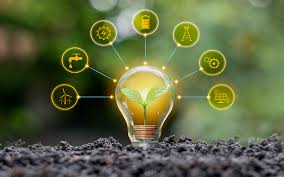The Rise of Green Technology: A Sustainable Future
Green technology, also known as clean technology, is a rapidly growing sector that focuses on creating innovative solutions to environmental challenges. With the increasing awareness of climate change and the need for sustainable practices, green technology plays a crucial role in shaping a more eco-friendly future.
Key Features of Green Technology
Green technology encompasses a wide range of practices and innovations aimed at reducing carbon footprints, conserving natural resources, and minimising pollution. Some key features include:
- Renewable Energy: Technologies such as solar panels, wind turbines, and hydroelectric power harness renewable energy sources to generate electricity without depleting fossil fuels.
- Energy Efficiency: Energy-efficient appliances, smart buildings, and LED lighting systems help reduce energy consumption and lower greenhouse gas emissions.
- Sustainable Transportation: Electric vehicles, public transport systems, and bike-sharing programmes offer eco-friendly alternatives to traditional petrol-powered vehicles.
- Waste Management: Recycling facilities, composting methods, and waste-to-energy technologies help divert waste from landfills and promote a circular economy.
- Water Conservation: Water-saving devices, rainwater harvesting systems, and advanced irrigation techniques help preserve freshwater resources and protect aquatic ecosystems.
The Benefits of Green Technology
Embracing green technology brings numerous benefits to individuals, businesses, and the planet as a whole. Some advantages include:
- Environmental Protection: By reducing pollution and resource depletion, green technology helps safeguard ecosystems and biodiversity for future generations.
- Economic Growth: Investing in green technologies creates jobs, stimulates innovation, and drives economic growth in sustainable industries.
- Health Improvement: Cleaner air quality, reduced exposure to toxins, and healthier food production contribute to improved public health outcomes.
- Climate Mitigation: Green technologies play a vital role in mitigating climate change by lowering carbon emissions and promoting carbon-neutral practices.
The Future of Green Technology
The future of green technology looks promising as more governments, businesses, and individuals embrace sustainable practices. Advancements in renewable energy storage, smart grid systems, circular economy models,
and climate-resilient infrastructure will further accelerate the transition towards a greener world.
In conclusion,
green technology offers practical solutions to environmental challenges while promoting social equity
and economic prosperity. By integrating green principles into everyday life,
we can collectively work towards building a more sustainable future for all.
Let us continue to support
innovative green technologies that pave the way for a cleaner,
healthier planet for generations to come.
Together,
we can make a difference!
Top 8 Frequently Asked Questions About Green Technology
- What is green IT technology?
- Why is green technology important?
- What is green technology today?
- Why green technology is the future?
- What are 5 types of green technology?
- What is green process technology?
- What is another name for green technology?
- What is an example of green technology?
What is green IT technology?
Green IT technology, also known as sustainable or eco-friendly IT, refers to the practice of designing, manufacturing, using, and disposing of information technology products in an environmentally responsible manner. Green IT technology aims to reduce the environmental impact of IT operations by promoting energy efficiency, minimising electronic waste, and adopting renewable energy sources. By implementing green IT practices such as virtualisation, cloud computing, and recycling initiatives, organisations can lower their carbon footprint and contribute to a more sustainable future for the planet.
Why is green technology important?
The importance of green technology lies in its ability to address pressing environmental issues and promote sustainable practices for a cleaner, healthier planet. By harnessing renewable energy sources, improving energy efficiency, and reducing carbon emissions, green technology plays a crucial role in mitigating climate change and protecting natural ecosystems. Furthermore, embracing green technology not only helps preserve valuable resources but also fosters economic growth, creates new job opportunities, and enhances public health outcomes. Ultimately, the adoption of green technology is essential for building a more resilient and environmentally conscious society that can thrive in harmony with the planet.
What is green technology today?
Green technology today refers to a diverse range of innovative solutions and practices that prioritise sustainability and environmental responsibility. From renewable energy sources like solar and wind power to energy-efficient appliances and eco-friendly transportation options, green technology encompasses initiatives that aim to reduce carbon footprints, conserve natural resources, and minimise environmental impact. In essence, green technology represents the ongoing commitment to harnessing technological advancements for the betterment of our planet, promoting a more eco-conscious way of living for a greener and more sustainable future.
Why green technology is the future?
Green technology is widely regarded as the future due to its pivotal role in addressing pressing environmental concerns and promoting sustainability. As the world faces escalating challenges such as climate change, resource depletion, and pollution, the adoption of green technologies offers a viable pathway towards a more eco-friendly and resilient future. By harnessing renewable energy sources, enhancing energy efficiency, and prioritising sustainable practices, green technology not only mitigates environmental damage but also fosters economic growth, enhances public health, and ensures a more secure and stable planet for generations to come. Embracing green technology is essential for building a greener, cleaner, and more sustainable world that benefits both people and the planet in the long term.
What are 5 types of green technology?
There are several types of green technology that play a crucial role in promoting sustainability and environmental conservation. Five key types include renewable energy sources such as solar power and wind energy, energy-efficient technologies like LED lighting and smart appliances, sustainable transportation options including electric vehicles and public transit systems, waste management solutions such as recycling facilities and composting methods, and water conservation practices like rainwater harvesting and efficient irrigation techniques. Embracing these green technologies can significantly reduce our ecological footprint and contribute to a more sustainable future for our planet.
What is green process technology?
Green process technology refers to the application of environmentally friendly practices and sustainable methods in industrial processes and manufacturing operations. It focuses on reducing energy consumption, minimising waste generation, and lowering carbon emissions throughout the production chain. By implementing green process technology, industries can enhance efficiency, improve resource utilisation, and mitigate environmental impacts. This approach not only contributes to a cleaner and greener environment but also promotes long-term sustainability in various sectors by prioritising eco-conscious strategies and innovative solutions.
What is another name for green technology?
Another term commonly used to refer to green technology is “clean technology.” Clean technology encompasses environmentally friendly practices and innovations that aim to reduce negative impacts on the environment while promoting sustainability and resource efficiency. This term highlights the focus on developing technologies that contribute to a cleaner, greener future for our planet.
What is an example of green technology?
An example of green technology is solar panels, which harness sunlight to generate clean and renewable electricity. Solar panels are a sustainable alternative to traditional fossil fuel-based power sources, as they do not produce harmful emissions or contribute to climate change. By converting sunlight into energy, solar panels help reduce reliance on non-renewable resources and promote a more eco-friendly approach to power generation. Their widespread adoption represents a significant step towards a greener and more sustainable future.


